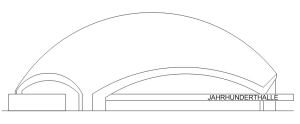
first known approach to electronic manipulation of room acoustic parameters
RCA installed loudspeakers in the room fed with microphone signals picking up stage signal
the goal: to extend reverberation time
R. Vermeulen developed a stereo enhancement system to produce artificial reflections
Philips Laboratories installed the system at the La Scala opera house in Milano
used tape machines as ‘echo processors’ delivered the room acoustic signals fed to the distributed loudspeaker system
- 1 recording head fed by microphones in the hall (stage pick up)
- 8 playback heads, each for a group of loudspeakers
system design by Heinrich Kuttruff und Erwin Meyer
chamber reverberator of 144 m³ with an additional reverb plate was installed in a dedicated room
the largest reverberation chamber at this time
signal pickup by microphones near stage, signal playback though a large number of loudspeakers
problems: low gain, coloration
 |
developed by P. H. Parkins (Building Research Station, England, first installed at the Royal Festival Hall, London in 1964
regenerative system, reverberation time could be extended from 1.4 to 2.5 seconds
large number of very narrow band channels with controlled feedback
At the Royal Festival Hall: 172 channels used, in the range of 58–700 Hz, channel spacing by a few Hz only
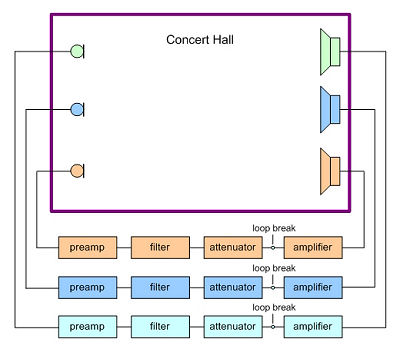 |
the technology was used for thousands of concerts in the 1960s and 1970s
another large installation: the Central Hall of the University of York, installed 1974, overhauled in 1985, multipurpose hall with 1200 seats
In 1971 Christopher Jaffe (Jaffe Acoustics, US) started working on generating ‚artificial‘ reflections, patented in 1977
simulating reflective energy to enhance perception of presence, definition, and warmth
72 channel delay tap filter, first reflections over proscenium speakers, later reflections low-pass filtered over ceiling speakers
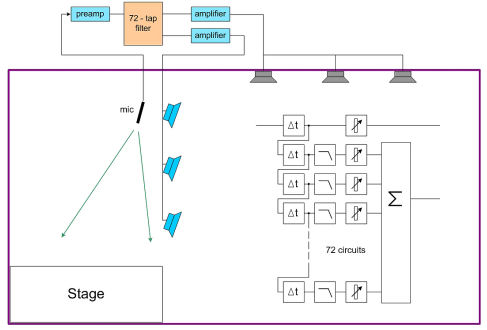 |
from 1982 Jaffe Acoustics and Acoustic Management Systems, Ltd. worked together and 1985 the RODS system was developed by Peter Barnet
RODS was an add-on to the ERAS system, using an additional reverberation processor
individual switching of channels, to avoid feedback, regulated by levels
developed 1968 by Franssen (Philips Laboratories), development based on Assisted Resonance System
it is a regenerative system
large number of broadband channels, controlled feedback, the higher the number of channels, the higher the achievable gain
to double the energy density at least 50 channels are necessary
each microphones feeds one channel with one loudspeaker
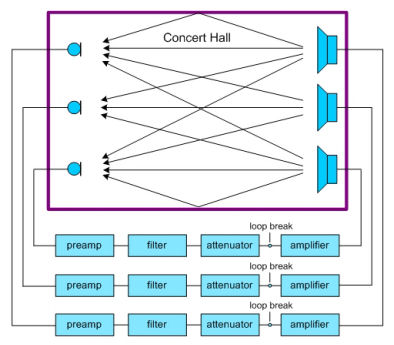 |
“increasing the energy density” equivalent to “decreasing the absorption”
microphone placed in the reverberant field amplified loudspeaker outside the reverberation radius
> the reverberant energy in the room will increase
increase by each loudspeaker is added to the total energy increase
the number of channels can be calculated by the required energy enhancement
MCR enhances EDT and decreases C80, but doesn‘t create an artificial ‚reverberation tail‘
works very well in larger rooms but not in smaller ones
problems of the first generation systems: with analog circuitry long-time stability was hard to achieve !
in den 1980s further development on the system by S.H. de Koning (Philips)
many high level installations all over Europe
large improvements in the 2000s by Peutz B.V. and Cees Mulder, using digital signal processing (Peavey Mediamatrix)
developed by Prof. Berkhout, University Delft, Netherlands
it is a non-regenerative system
each loudspeaker is fed with an individual ‚impulse response‘ according to the needs of the designed room
theoretically based on wave field synthesis
the existing hall is ‚overlaid‘ with an artificial hall image
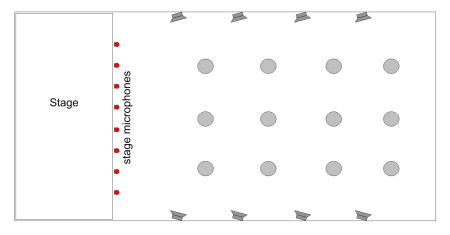 |
8 to 24 directional microphones
processor: early reflection module, reverberation module
as much loudspeaker channels as possible are used
developed with analog circuitry, later transformed to digital
developed by David Griesinger and Steve Barbar at Lexicon, Inc. later LARES Associates
it is a non-regenerative system
the first installation at the Elgin Theatre, Toronto, using 2 microphones and 116 loudspeaker channels
LARES uses the so-called „time variant processing“: special algorithm for delay changes and minimized pitch shift, compromise between coloration-free gain and audible pitch problems
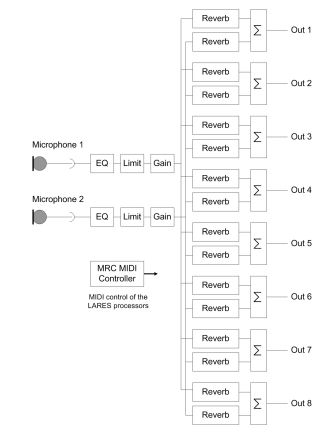 |
natural reverberation of the room and full artificial reverberation is mixed in the room
LARES increases lateral energy and increases the reverberant field
2 - 4 cardioid microphones as close to the stage as possible
2 LARES processors provide 16 independent reverberation channels
1992 a patent was issued for LARES entitled "Electroacoustic system"
developed by Wim Prinssen
it is a non-regenerative system
4 - 8 supercardioid microphones close to the stage, 8 - 10m above front edge of stage
time-constant de-correlation of the individual microphone channels (time-variance available)
with a large number of de-correlated signal paths / loudspeaker channels usually about 30 loudspeaker channels
retains acoustical character of the hall, but fills missing reflections
system should not have acoustic feedback between loudspeakers and microphones
uses sophisticated reverb algorithms
developed by Mark A. Poletti, New Zealand
it is a regenerative system
using the acoustic feedback between loudspeakers and microphones
omnidirectional microphones full-range loudspeakers with very wide dispersion pattern
multichannel unitary reverberator maintaining a constant power gain with frequency
system is creating an electro-acoustically coupled room
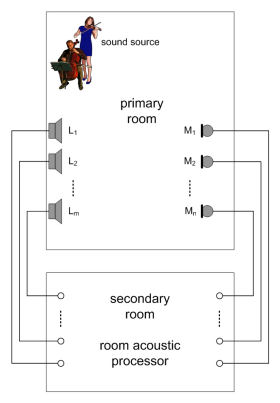 |
reverberator is time - invariant
microphone signals are mixed with a special mix-algorithm to generate a summed microphone mix feeding reverberator modules, these feeding the loudspeaker channels
additional ‚in-line‘ early reflection module working with directional close-stage microphones
patent issued in 1993
developed by Vian, France
active wall principle
each unit is equipped with microphone, processor/amplifier and loudspeaker
a quantity of units is used to built an „active wall“
each cell captures and renders sounds in real time
a digital processing unit handles the signals in real time
developed by Yamaha Corp.
it is a regenerative system
uses an array of 4 or 8 omnidirectional microphones, installed outside reverberation radius
microphone spacing should be at least half the wave length of the lowest reproduced frequency
signals are fed to a so-called „microphone rotator“ that changes input and output combinations periodically every 1/3 second to 2 seconds
FIR filtering (fluc FIR) is used to control feedback further by moving each FIR tap periodically
Two systems are used: early reflections and reverberation field
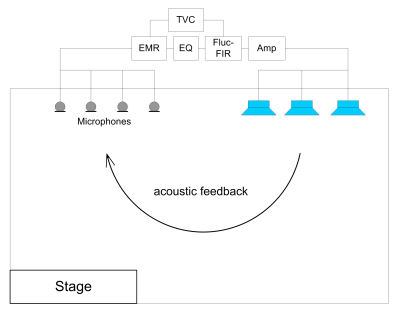 |
developed by LARES Associates
room acoustics system incorporating microphones, loudspeakers, and signal processing
lifts the acoustic level in a conference room, to improve speech levels without visible microphones
creates a natural room acoustic feeling, microphones are located in ceiling and walls, even close to loudspeakers
systems are custom designed, loudspeakers can also be used for sound playback (DVD)
Meyer Sound entered the market of electronic architecture in 2005 after acquiring LCS Audio
the former VRAS system is further developed and now called “Constellation”
packaged system with certified Meyer Sound loudspeakers and certified microphones
each system is programmed and tuned only by certified Meyer Sound personnel
developed by Mueller BBM, Munich, marketing by Stagetec
it is a non-regenerativ system
convolution algorithm
input/output matrix in combination with sound reinforcement
claim:“can recreate almost any environment in a low-reverberant space”
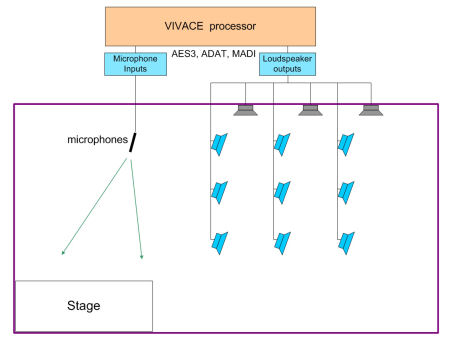 |